Introduction
Japanese manga is a global pop-culture icon. Its origins trace back to ancient times, evolving over the centuries, and continuing to captivate people worldwide today. Manga’s diversity and appeal are deeply intertwined with Japanese culture, history, and contemporary society. This article will explore and touch the surface of the rich history and enduring allure of Japanese manga culture in super shortened and easy article.
目次
Definition of Manga
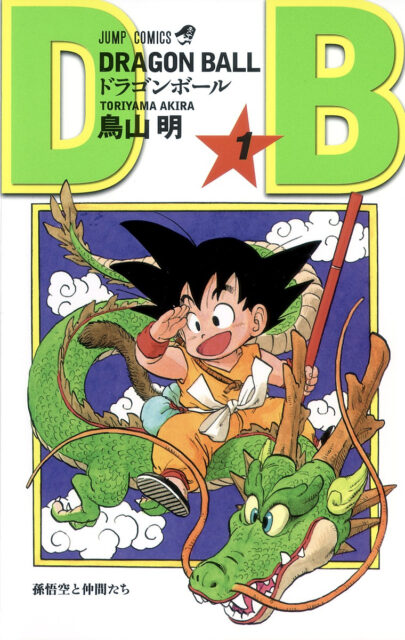
What comes to mind when you hear the word “manga”? Many popular works, like “Dragon Ball” and “Naruto,” might spring to mind. While you might be familiar with these series through their anime adaptations, this explanation will focus on the original manga.

The definition of manga varies widely. Generally, people think of manga as works divided into panels, where the story is told through a combination of text and illustrations. However, manga encompasses a broad range of styles and expressions, making it difficult to strictly define. Manga has evolved through different cultures and eras, constantly transforming from its early forms to what we know today. Let’s explore these changes and the historical trends that have shaped manga.
The Origins of Manga Beginning with Picture Scrolls

The history of manga in Japan is seen back to the 12th century. During the Nara to Muromachi periods, “picture scrolls” emerged as an early form of storytelling through images. Initially, pictures were added beside texts to make scriptures from China more understandable.
To view a picture scroll, you open it with your left hand and roll the shaft to the left side, viewing it from right to left. As you continue, you gradually roll it up with your right hand, allowing the scroll to unfold in both time and space from right to left, which is opposite from European style.

As picture scrolls evolved, they began to cover a wide range of genres, including scriptures, stories, sagas, and battles. One of the most notable early examples is the “Chōjū-jinbutsu-giga” (literally “Animal-person Caricatures”), considered a forerunner of modern manga. This four-volume picture scroll, produced in the 12th century (late Heian to Kamakura periods), is often attributed to Toba Soujou Kakuyu (鳥羽僧正覚猷), though the authorship is uncertain. The scrolls feature anthropomorphic animals and satirically depict the society and culture of the time, with humor reminiscent of modern manga.
Laughter and Satire in Edo

However, it wasn’t until the Edo period (1603-1868) that we began to see a form of cartooning similar to today’s manga. The Edo period can be considered the origin of Japan’s manga culture, marked by the creation of many illustrated books and caricatures as popular culture flourished and various forms of entertainment developed.

One popular form of illustrated books from this period was “Kusazōshi,” or “grass paper.” Kusazōshi were categorized into akahon, aohon, kurohon and kibyōshi, each targeting different readerships and featuring different content. Akahon, or “red books,” were picture books mainly for children, often with didactic stories. Kibyoshi, or “yellow-covered books,” were intended for adults and featured stories filled with satire and humor. These illustrated paperbacks laid the foundation for modern comic storytelling.

Ukiyo-e, a woodblock print art form depicting the life, scenery, and customs of common people, also had a significant influence on manga’s development. Among ukiyo-e, caricatures and humorous drawings, particularly those called giga (caricatures), bear a resemblance to modern manga in their expression.
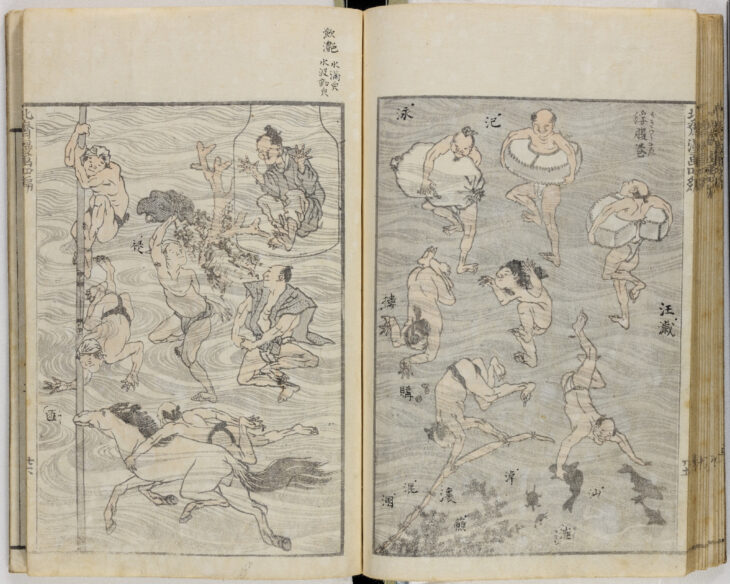
One of the most famous Ukiyoe artist was Katsushika Hokusai (1760-1849), who published a series of picture books called “Hokusai Manga.” In these books, he depicted a wide variety of people, animals, and landscapes. The word “manga” combines the Chinese characters “man,” meaning “at will,” and “ga,” meaning “picture,” which Hokusai used to mean “pictures drawn in a rambling manner.” Although Hokusai Manga did not have a storyline, it featured a series of drawings rich in movement and facial expressions, similar to the way modern manga conveys emotion and action. Hokusai’s manga were highly acclaimed for their variety of drawing techniques and expressions, greatly influencing later manga and anime.
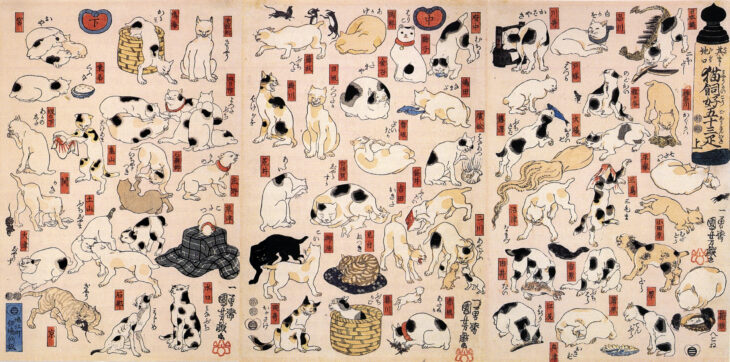
Another important Ukiyo-e artist was Utagawa Kuniyoshi (1797-1861). He produced many caricatures that cleverly mixed humor and satire, making them very popular among the common people. His satirical drawings often anthropomorphized cats and fish, containing subtle critiques of the society and politics of his time. Such satirical expressions became a vital element in later cartoon culture.

In the late Edo period, multicolor ukiyo-e called nishiki-e appeared. This allowed for the creation of colorful illustrations for picture books and kusa-zoushi, making them more visually appealing. The technique of nishikie can be considered the basis of modern full-colored manga.
Changes in the Meiji Era
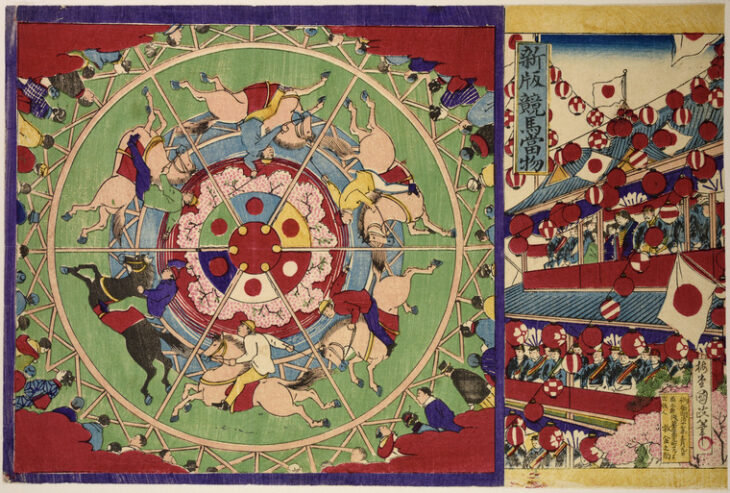
During the Meiji Era (1868-1912), manga in Japan underwent significant changes due to the influence of Western culture. With the introduction of Western technology and culture during Japan’s period of modernization, manga styles evolved, laying the foundation for modern manga. Caricatures and current affairs cartoons, which critically and humorously depicted social and political events, became particularly popular among the general public during this time.
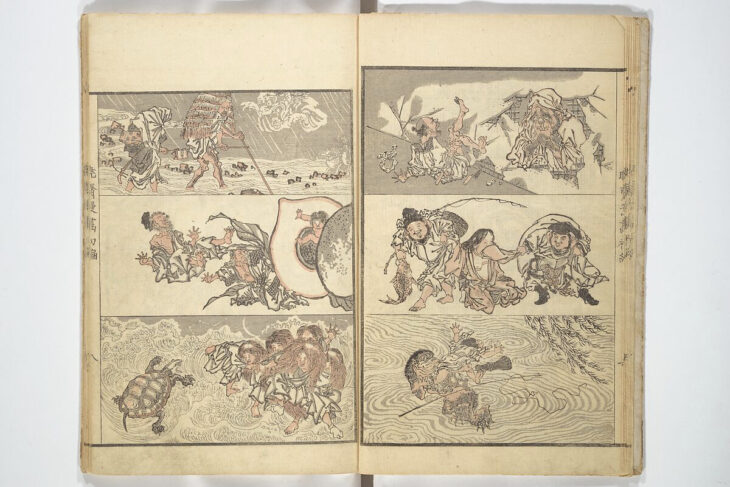
One of the leading artists of this period was Kawanabe Kyosai (1831-1889). Although he was best known as an Ukiyo-e artist, Kyosai also created many works incorporating Western drawing techniques. His masterpiece “Kyosai Manga” features lively depictions of a wide variety of people, animals, and landscapes, characterized by rich movement and facial expressions reminiscent of modern manga. Kyosai’s works, which fused traditional Japanese painting with Western influences, had a significant impact on the development of manga culture.
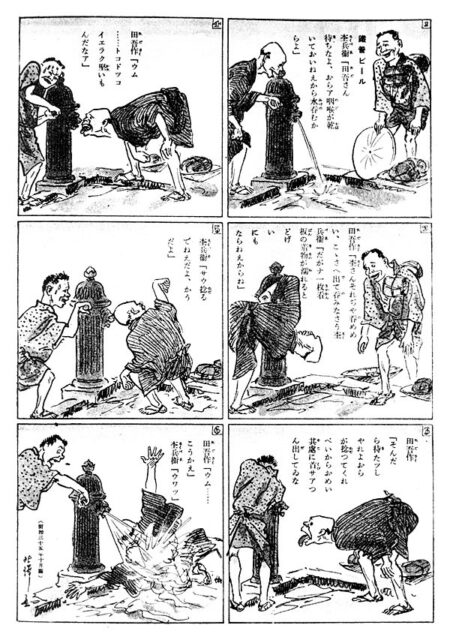
In the late Meiji period, more modern forms of manga began to appear. Kitazawa Rakuten (1876-1955) is recognized as a pioneer in this field. Rakuten published numerous satirical cartoons in newspapers and magazines and launched Japan’s first full-fledged manga magazine, Tokyo Pack. His works, which humorously and satirically depicted political and social issues, resonated deeply with readers of the time. Influenced by American cartoons, Rakuten’s style featured simple but strong-line of drawings and humor, which greatly influenced later cartoonists.
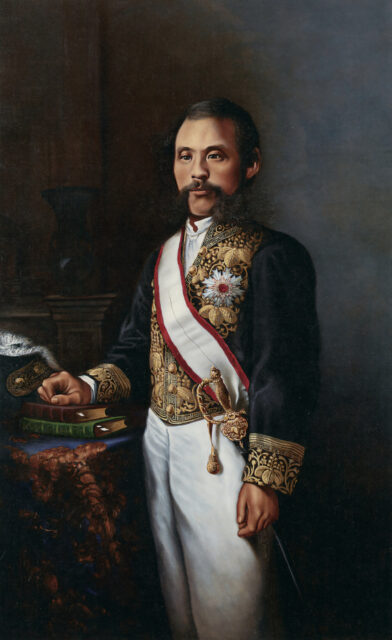
The introduction of Western painting techniques during the Meiji period led to more diverse pictorial expressions in manga. These new techniques allowed for more realistic expressions and depictions of movement, greatly enhancing the expressive power of manga and leading to an increase in narrative works.
Taisho Romanticism and Manga Adventures

Next, let us look at the Taisho period (1912-1926). This era was marked by rapid modernization and social change in Japan, heavily influenced by international trends following World War I. Manga during this period diversified and evolved, exploring new methods of expression and themes.
The Taisho era was characterized by a liberal climate known as Taisho democracy, which increased freedom of expression. In this environment, manga transcended mere entertainment and began to be used for social satire and political criticism. The widespread availability of newspapers and magazines helped cartoons reach a larger audience, influencing many people.

One of the prominent cartoonists of the Taisho era was Ippei Okamoto (1886-1948). He joined a newspaper company in 1912 as an illustrator. At that time, single-panel illustrations called koma-ga were the main type of newspaper illustrations. However, Okamoto developed his own style of “manga manbun” (漫画漫文) by adding light-hearted text to his panel drawings. This innovation had a significant impact on the manga world of the time and became the mainstream of manga expression during the Taisho era. Okamoto initially referred to himself as “Manga-ko” (cartoonist) but later became known as “Manga-ka.” In 1915, Okamoto formed Japan’s first manga artists’ organization, the Tokyo Manga-kai, which mainly consisted of manga artists who worked for newspaper companies. With the rise of “professional cartoonists,” the number of cartoons published in newspapers and magazines expanded.
During this period, the influence of Western culture became even stronger. Western techniques and art styles were incorporated, enriching the expression of manga. The addition of realistic depictions and dynamic movement made manga more visually appealing and sophisticated.
A Postwar Miracle and Heroes of the Showa Era

The Showa period (1926-1989) was a time of significant growth for Japanese manga, both domestically and internationally. Following World War II, Japan rose up from the devastation to be experiencing rapid reconstruction and economic development. During this era, manga played a crucial role in Japanese society, evolving into a vital form of expression. In the postwar period, when Japan was grappling with chaos and despair, manga provided its hope, entertainment and emotional supports.
Especially in the mid to late Showa period, manga entered to a “Golden age,” marked by the emergence of numerous renowned manga artists. This was a pivotal time when manga became an integral part of popular culture and had a profound impact on society.
Osamu Tezuka and the Manga Revolution
During this period, manga further evolved and became widely read by many people. Inexpensive comic books called “akahon,” or comic books available for rent at book rental shops, became especially popular. These akahon, which had appeared in the Edo period filled with ukiyo-e prints, shifted in content to manga around the Taisho period (1912-1926). After World War II, the term referred to comic books created by toy stores and printers as a sideline business, initially intended only for children. This changed dramatically with the arrival of a superstar.
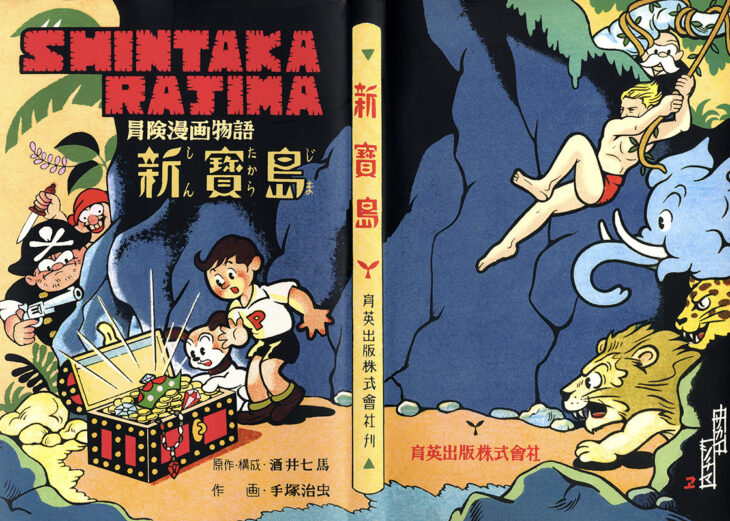
Tezuka Osamu and his 1947 book-length debut, “New Treasure Island” (Shin Takarajima).
Tezuka’s work incorporated cinematic frame layouts and dynamic action scenes, setting it apart from conventional manga. Many young readers were shocked and inspired by his work, with many aspiring to become manga artists themselves. Tezuka’s influence extended to Japan’s leading creators, including Fujiko Fujio, the creator of Doraemon, and Hayao Miyazaki, the master of animated works from Studio Ghibli.

Tezuka produced many masterpieces, including “Mighty Atom” (Tetsuwan Atom) and “The Jungle Emperor,” (Jungle Taitei) which established the modern manga style. His works were not merely entertainment for children; they also depicted deep themes and human drama, elevating manga to a higher level of art. Works such as “Phoenix” (Hi no Tori) and “Black Jack” dealt with philosophical elements and social themes, gaining popularity among adults as well. Tezuka Osamu, known as the “God of Manga,” profoundly influenced many subsequent manga artists.
Social Issues and Manga Themes

Postwar Japanese society underwent significant changes alongside rapid economic growth. During this period, many manga works emerged that focused on memories of war and social issues. For example, Shigeru Mizuki’s “GeGeGe no Kitaro” became popular for its unique worldview that mixed humor and horror while depicting the tragedy of war.
Similarly, “The Legend of Kamui” (Kamui den) by Sanpei Shirato was highly regarded for its deep social messages, portraying the contradictions of feudal society and human dignity. These works showcased how manga could address complex social themes and reflect the concerns of Japanese society during times of change.
The Rise of Manga Magazines
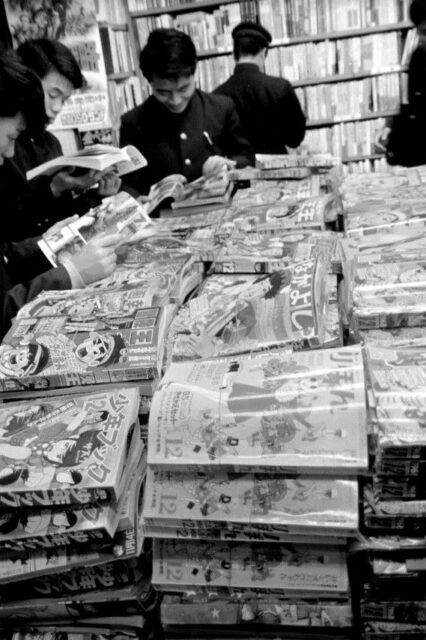
From the mid to late Showa period, many manga magazines were launched, including “Weekly Shōnen Jump“, “Ribbon”, and “Margaret”. These magazines regularly serialized new works, providing a platform for introducing new works and artists to their readers. “Weekly Shōnen Sunday” and “Weekly Shōnen Magazine”, both launched in 1959, were the first weekly manga magazines and were highly successful. In 1967, Japan’s first weekly youth manga magazine, “Manga Action”, was born. “Weekly Shōnen Jump” produced numerous hits under the themes of “Friendship, Effort, and Victory,” establishing manga as an everyday entertainment and gaining a large readership.
The Development of Shōnen and Shōjo Manga
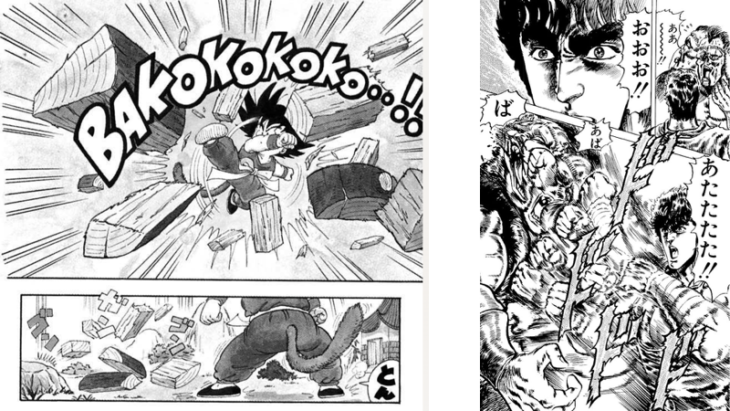
During the Showa period (1926-1989), shōnen manga (boys’ manga) and shōjo manga (girls’ manga) evolved in unique ways. In shōnen manga, authors such as “Akira Toriyama” of “Dragon Ball” and “Buronson/ Tetsuo Hara” of “Fist of the North Star” (Hokuto no Ken) created popular works with themes of adventure and battle.
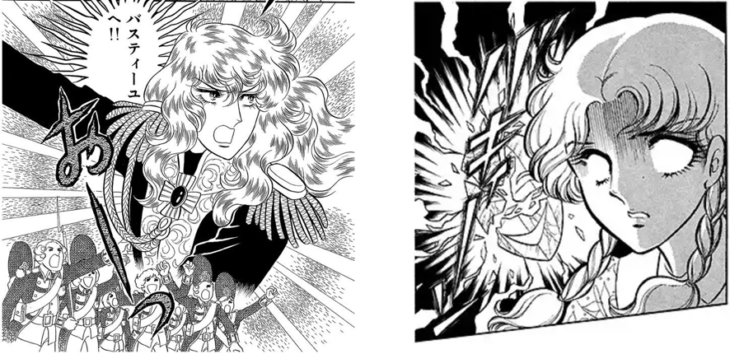
In the shōjo manga genre, works depicting complex human relationships and romance, such as “Riyoko Ikeda”s “The Rose of Versailles” (Versaiyu no Bara) and “Suzue Miuchi”’s “Glass Mask,” (Garasu no Kamen) captured the hearts of many female readers.
Animation and Media Mix

During the Showa period, many manga works began to be adapted into animated cartoons, reaching an even wider audience through television and film. When “Osamu Tezuka”‘s “Astro Boy” was adapted into an animated TV series in 1963, it became very popular and pioneered the media mix between manga and anime. “Sally the Witch” (Mahou-tukai Sally), based on the manga by “Mitsuteru Yokoyama”, is another representative work. These early animated works were immensely popular with children and promoted the mutual influence of manga and anime. This led to the sale of character goods and related products, making manga culture a huge commercial success.
Social Impact and International Recognition
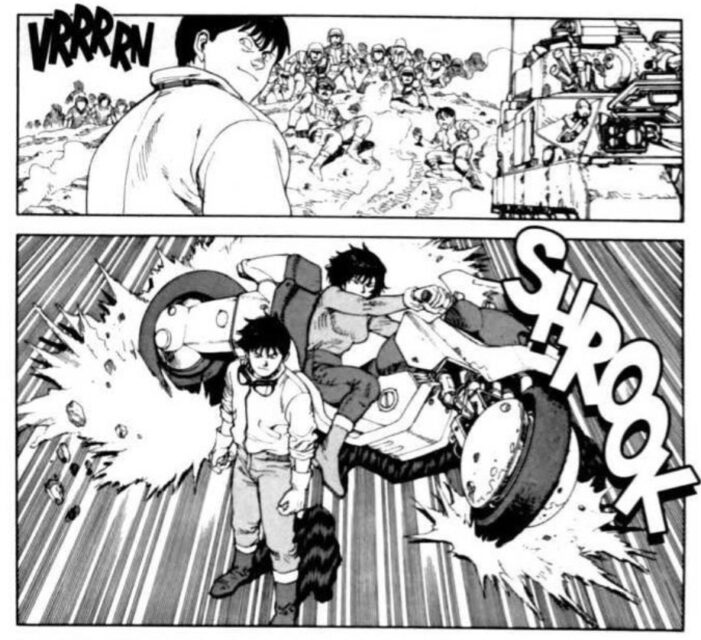
Manga during the Showa period was not limited to mere entertainment; many works addressing social issues and containing moral lessons also appeared. These works were translated into many languages, helping to spread Japanese manga culture worldwide. Especially in the 1980s, Japanese manga became popular in the U.S. and Europe, gaining international recognition.
The Diverse Manga World of Today
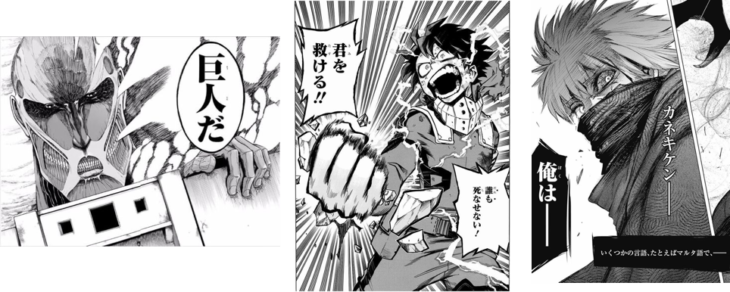
Modern Japanese manga continues to build on its historical development and diversify further. Manga is now popular among children and adults of all ages and covers a wide range of genres and themes. With the evolution of digital technology and global dissemination, contemporary manga has found new venues of expression and is reaching a large audience.
In addition to traditional shonen and shojo manga, diverse genres of manga have emerged today. For example, “Attack on Titan” (Shingeki no Kyojin) by Hajime Isayama combines dark fantasy and action, gaining great popularity in Japan and abroad. Similarly, “My Hero Academia” (Boku no Hero Academia) by Kohei Horikoshi, despite its superhero theme, has developed a new readership by depicting human drama and a story of growth. Dark horror works such as “Tokyo Ghoul” by Sui Ishida also address social issues and deep themes that explore human nature.
International Influence and Collaboration

Contemporary Japanese manga is highly acclaimed abroad, with many works translated and read around the world. Especially in the U.S. and Europe, Japanese manga has experienced a significant boom and has gained a large number of fans. For example, “NARUTO” by Masashi Kishimoto and “ONE PIECE” by Eiichiro Oda have become bestsellers overseas and are widely recognized as representative of Japanese culture.
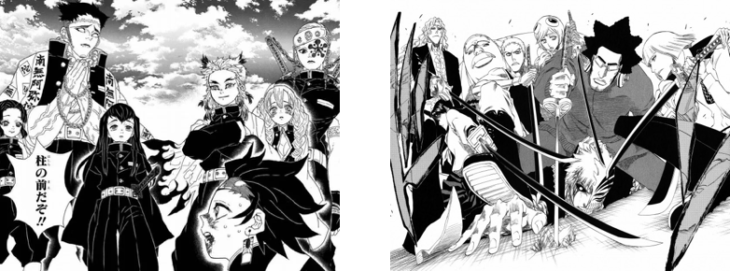
Additionally, manga that feature traditional Japanese weapons and costumes, such as “Demon Slayer” (Kimetsu no Yaiba) by Koyoharu Gotouge and “BLEACH” by Taito Kubo, have increased the number of overseas fans interested in Japanese language and culture, likely strengthening cultural ties between Japan and other countries.
Cultural and Social Impact
Manga is more than just entertainment. It has the power to make readers think by addressing social issues and depicting diverse characters. Topics such as gender, race, environmental issues, and many others are explored through manga. It plays an important role in conveying social messages and its influence has spread both domestically and internationally, impacting various fields.
Education and Awareness

Manga has also been used as an educational tool. For example, “Cells at Work!” (Hataraku Saibou) by Akane Shimizu anthropomorphizes human cells to explain their functions in an engaging and understandable way, increasing children’s interest in biology and medicine. “Dr. STONE” (story by Riichiro Inagaki, illustrated by Boichi) portrays the excitement of science and the value of building civilization through a grand narrative of scientific advancement from scratch. These works demonstrate a new form of education that makes learning enjoyable.
Raising Social Issues

Manga has the power to highlight social issues and encourage readers to think deeply about them. In “A Silent Voice” (Koe no Katachi) by Yoshitoki Ōima, the issues of bullying and disability are depicted, raising awareness about these serious matters. Similarly, “The Promised Neverland” (Yakusoku no Neverland) by Kaiu Shirai and Posuka Demizu is set in a dystopian society but addresses the importance of freedom and hope, prompting readers to reflect on these themes. By tackling social issues through engaging stories, these works encourage awareness and action.
Gender Issues
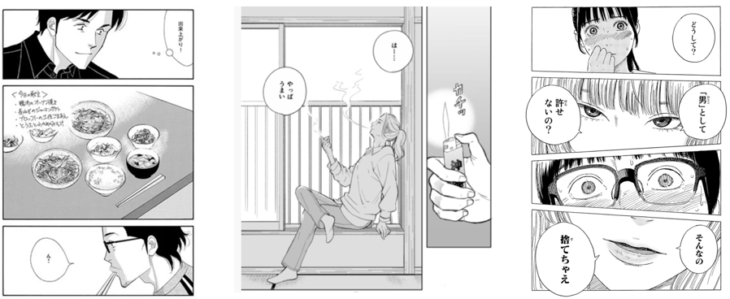
Manga also explores gender issues through various narratives. “What Did You Eat Yesterday?” (Kinou Nani Tabeta?) by Fumi Yoshinaga depicts the lives of a gay couple, exploring the meaning of living together through daily meals while dealing with societal values and conflicts. “Hitorimi desu” (It means “I am living alone.”) by AKIKO portrays the life of a single 60-year-old lesbian. “Welcome Back, Alice” (Okaeri Alice) by Shuzo Oshimi follows the story of a protagonist reunited with a childhood friend who challenges gender norms by wearing a schoolgirl uniform. These works demonstrate the diversity of sexuality and reinforce the notion that such diversity should be normalized.
The Digital Age and Globalization
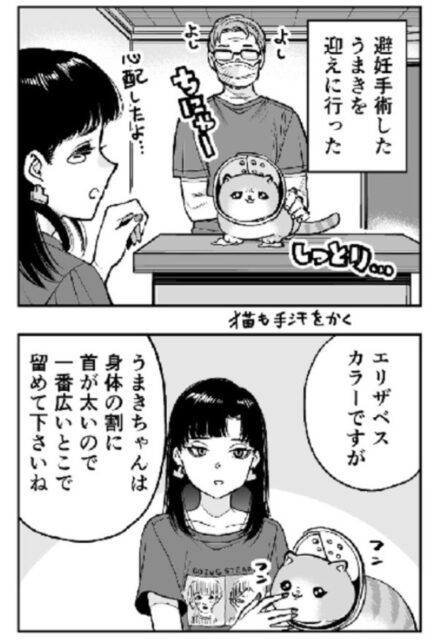
The Internet has dramatically transformed the world of manga. Web manga and digital platforms have made it easier for people to enjoy manga, while social media and online communities have enabled fans around the world to access Japanese manga. This shift has significantly changed the production, distribution, and consumption of manga, opening up new possibilities.
The Emergence of Digital Platforms

The proliferation of the Internet and e-books has led to a rapid expansion of digital distribution for comics. Many artists now publish their works on webcomic and e-book platforms, with an increasing number making their debut without traditional publishers. For example, “One-Punch Man” (Wanpanman) by ONE began as a webcomic, gaining immense popularity for its unique storytelling and humor. It was later commercially published and adapted into an anime, which helped it gain a worldwide fan base.
SNS and Fan Engagement

Social networking services (SNS) have brought writers and readers closer together. Platforms like Twitter and Instagram allow writers to communicate directly with readers and receive real-time feedback. This interaction helps creators to reflect readers’ opinions in their work, resulting in even more engaging and appealing content. For instance, “Chiikawa” by Nagano, which depicts the daily lives of small and cute creatures, and “Jimoto Saikou!”(It means “Hometown Supreme!”) by usagi, both benefit from direct fan engagement, enhancing their appeal.
Digital Archives and the Revaluation of Classic Works
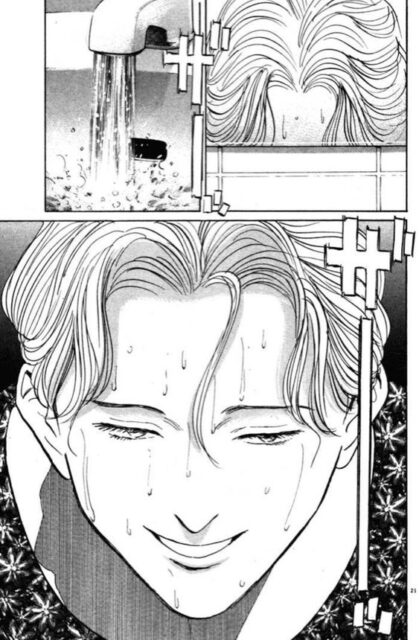
Digital technology is also being used to bring classic works back into circulation. Digital archiving has increased opportunities for classic manga to be rediscovered by new audiences. This allows masterpieces from the Showa and early Heisei eras to re-emerge, preserving their historical value with modern technology. For instance, Naoki Urasawa, the author of “20th Century Boys” (Nijusseiki Shōnen) and “MONSTER”, who previously avoided digitalization due to his preference for paper-based formats, began releasing his works digitally in 2021.
Conclusion

How was this brief introduction to the history of Japanese manga from ancient times to the present day? Some of you who have read this article may feel that it is impossible to discuss manga without mentioning iconic works like “AKIRA,” “Jojo’s Bizarre Adventure,” (Jojo no kimyouna bokken) and “Fullmetal Alchemist.” (Hagane no Renkinjutusi) Indeed, there are many great manga that represent the world and have left a lasting impact, far too many to cover comprehensively here. Please understand that while we have not been able to list every significant work, the history of Japanese manga is deep and extensive.
Japanese manga has continually evolved through its varied histories. Each era has produced works reflecting its social issues and zeitgeist. Universal themes have been constantly explored and depicted, attracting audiences not only in Japan but around the world. As technology evolves, manga will continue to transform into newer forms, presenting innovative ways of storytelling and artistic expression.
The world of manga has unlimited potential and will continue to open up new possibilities. The rich history and dynamic nature of manga ensure that it remains a vital and influential part of global culture.
Written: Rei Maruyama


